by Dot Cannon
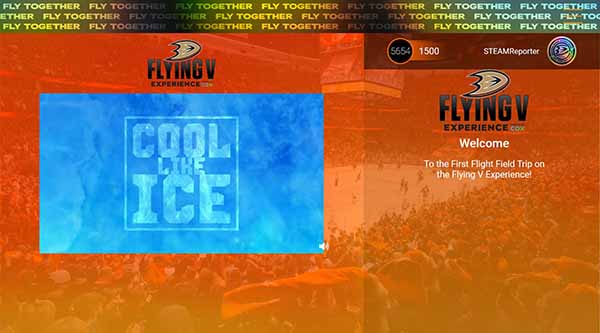
How do you get an ice rink ready for a top hockey team to do what they do best?
And, what is the science involved in doing so?
Those were the questions which the Anaheim Ducks’ first-ever all-virtual “First Flight Field Trip” examined, on Wednesday, March 2nd.
As mentioned in our previous post, the Ducks offer a unique educational program.
S.C.O.R.E., an acronym for Scholastic Curriculum of Recreation and Education, teaches academics, including math, science and reading, through the perspectives of hockey.
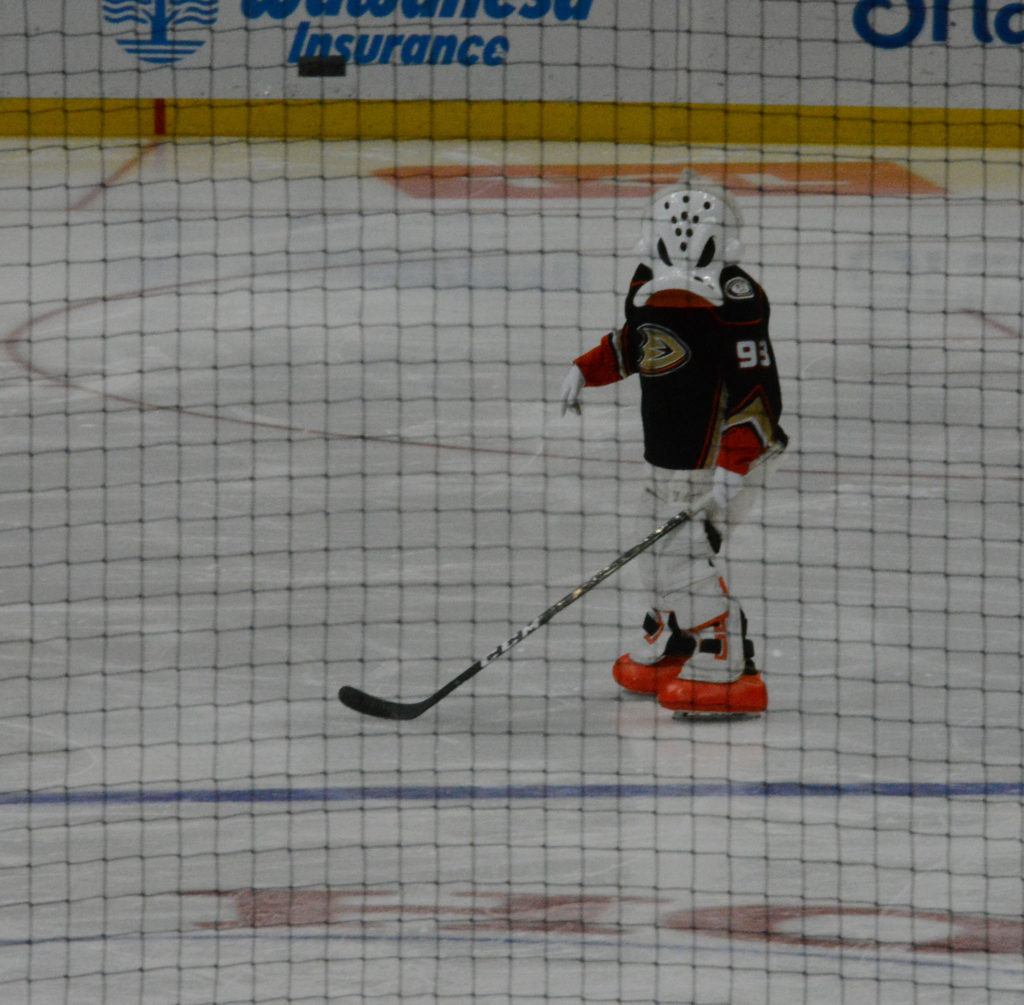
Annually, the Ducks host a free “First Flight Field Trip” for grades 3 to 6. With a focus on one scientific principle related to hockey, this special event is a lot of fun–while relating concepts in a way students will remember.
This year’s virtual offering, in a dramatized and gamified format, was no exception.
Themed “Cool As Ice”, the presentation centered around the science behind the ice on which players skate.
The premise: chief ice engineer Kevin Diamond falls while cleaning the ice. Believing him to be incapacitated, Ducks mascot Wild Wing learns that no one else is available to prepare the rink for an upcoming game.
The resourceful duck hurries off, to assume the responsibilities involved.

In the process, he recruits First Flight host Sammy Maldonado, First Flight DJ Jojo Maestrado–and the students watching the presentation, to help him.
By mid-morning, students had seen two ten-minute mini-lessons involving Ducks players, from onsite at the Ducks’ practice facility, Irvine Great Park Ice. With players Troy Terry, Kevin Shattenkirk , John Gibson and Trevor Zegras, Sammy and Wild Wing had explored principles of matter, and properties of heat.
Now, the time had come to talk about ice: specifically, the best ice for skating.
Going “Beneath the Surface”
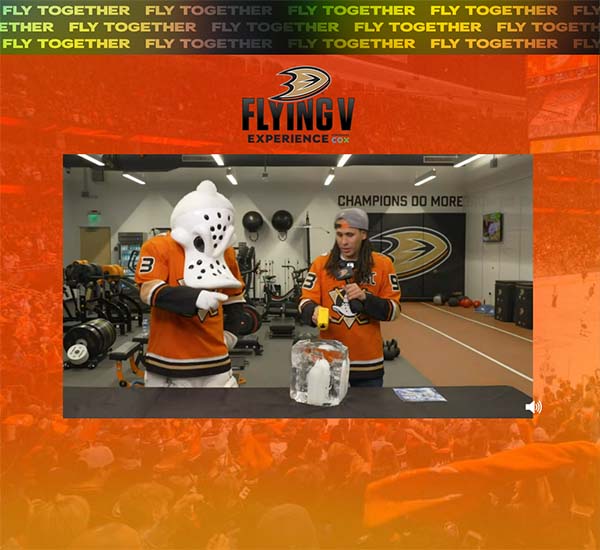
In the morning’s third mini-lesson, “Beneath the Surface”, Sammy, Wing and Ducks forward Max Jones explored the composition of three different types of ice.
“Knowing how to make good ice, is very important for hockey,” Max said.
So, what makes “good ice”? As Sammy observed, “not all ice is created equal”.
“Check this first one out,” Sammy said, indicating a glass container.
“That ice looks cloudy, it’s kind of brittle. It’s dry ice, there’s lots of gas trapped in that block.”
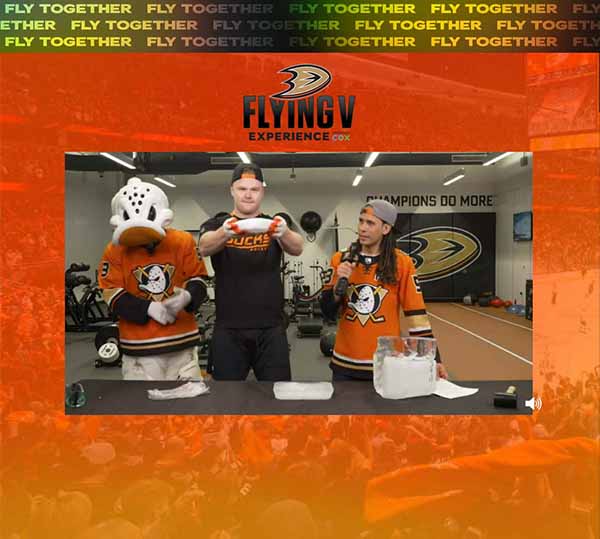
“The next piece looks like something from my freezer,” Max said.
“That piece still looks a little cloudy, but it is transparent in some spots,” Sammy observed.
“It feels heavier than the last piece too. More solid,” Max commented.
Then, they moved on to the third piece of ice.
“Now this is good ice,” Max said. “Why? Let me show you.”
Max and Sammy explained that the Ducks’ ice rink was made of “layers of ice, slowly frozen on top of one another.”
“One layer’s painted white, with lines and circles,” Sammy said. “More ice is layered to create a strong, clear sheet.”
“Not only can we see through it, it tends to be stronger,” Max explained. “This helps ice engineers keep the strongest surface possible for a game.”
Then, Max and Sammy tested that strength. Max wielded a hammer first over that cloudy piece of ice.
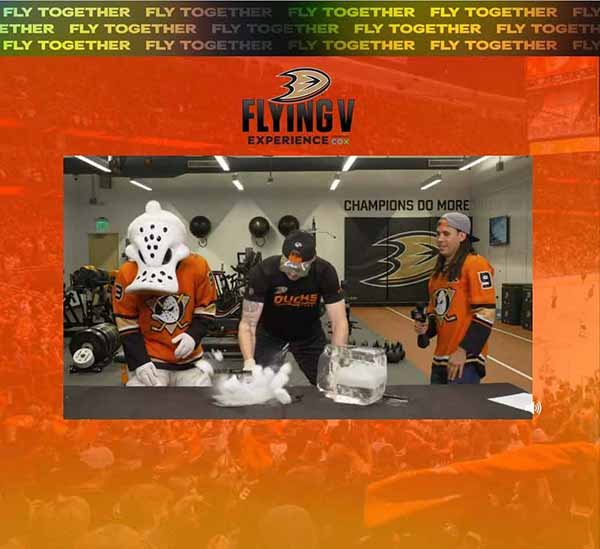
“Super brittle! Shattered everywhere,” Sammy said.
However, when they tried the same test on the clear, solid piece?
Not a chip.
“Huge difference! That is some super strong ice,” Sammy said.
Research and review
In between the mini-lessons, Jojo conducted “research” from the control room, in the form of a mini-quiz.
“When ice is made quickly, what often becomes trapped in it?” he asked, offering multiple-choice answers .
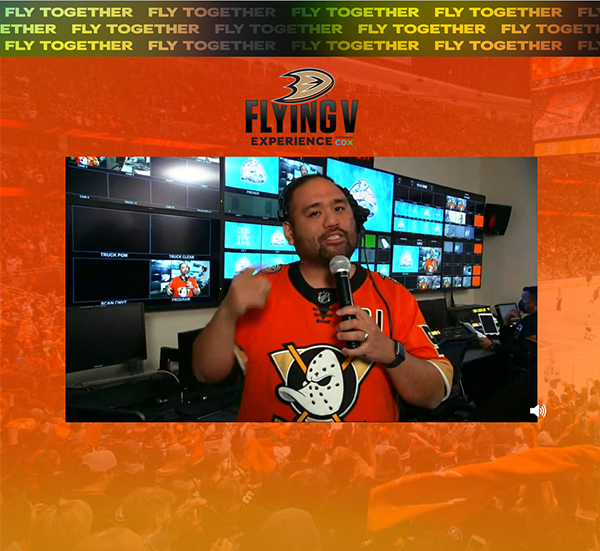
And the first correct answer, from among the students virtually joining the event, meant a prize!
“Ninety-five percent of you answered the correct answer, of ‘air’!” Jojo said.
(Due to this year’s virtual format, we don’t know the specific number of students participating in the Ducks’ 2022 First Flight Field Trip. However, Anaheim Ducks Manager of Fan Development Marketing Jason Cooper emailed, just after the event, that there had been 2,000 account registrations. He added that, while some students watch “First Flight” on their individual devices, an entire classroom can also be following along on one device.
Consequently, Jason says, while we won’t know a true count, we can assume there were somewhere between 8,000 and 9,000 viewers, in total, virtually attending this year’s program.)
The science behind “a slide on ice”
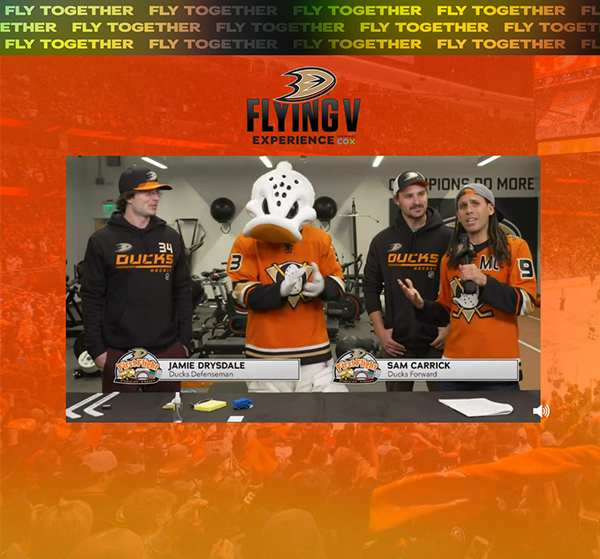
The time had come for the fourth, and final, mini-lesson of the 2022 “First Flight Field Trip”.
Aided by Ducks Defenseman Jamie Drysdale and Ducks Forward Sam Carrick, Wild Wing and Sammy explored “slide science”.
“Now, what I want to know is, how do we keep (the ice) playable, all season long?” Sammy said. “These guys rough it up a bit.”
“(Skates are) very sharp. After a period of play, we chew up the top layer of the ice,” Sam said.
So, with that uneven after-play surface, how can the puck glide smoothly in subsequent games?
With a fork, Jamie demonstrated how the players’ skates interact with the ice.
“Each prong of that fork is like a skate blade, ” Sammy said. “Look at how much snow it creates. Not smooth either.”
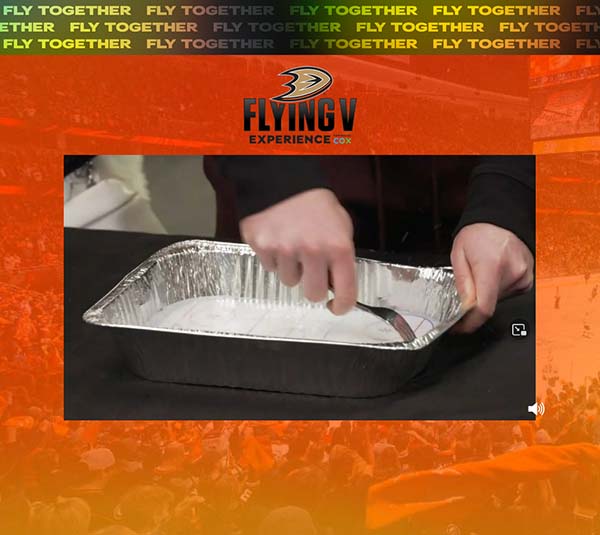
“That’s where the ice engineers help,” Jamie said. “They make this sheet new again with some simple fixes.”
A video followed, showing the Zamboni ice machine in operation. The process, Sam and Jamie explained, involved “brushing” the ice on one end, scraping off the “snow” and applying a thin layer of water to resurface the ice.
And finally, that layer of water would get spread out, filling in grooves to create a “smooth, flat surface”.
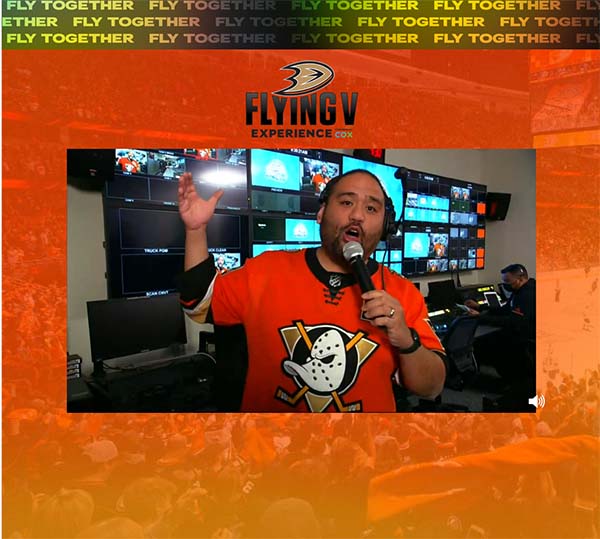
As Wild Wing and Sammy headed back to Honda Center–and the Zamboni ice resurfacer–Jojo quizzed the students, once again, on the “slide science” they’d just heard.
Then, Sammy and Wild Wing rejoined him for one final trivia question.
“What does the Zamboni ice resurfacer do?”
They also did a roll call of source: “Tap to Clap”. The goal: 250,000 taps!
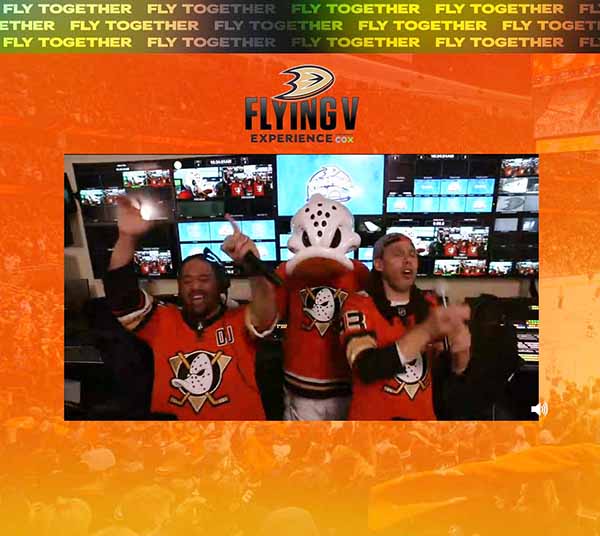
“Keep tapping! Keep tapping!” Jojo exhorted.
“My phone is about to die right now…are we there? We’re there!”
Amid cheers, Jojo gave away a prize: a classic Trevor Zegras first-edition bobblehead!
And–off to the tunnel
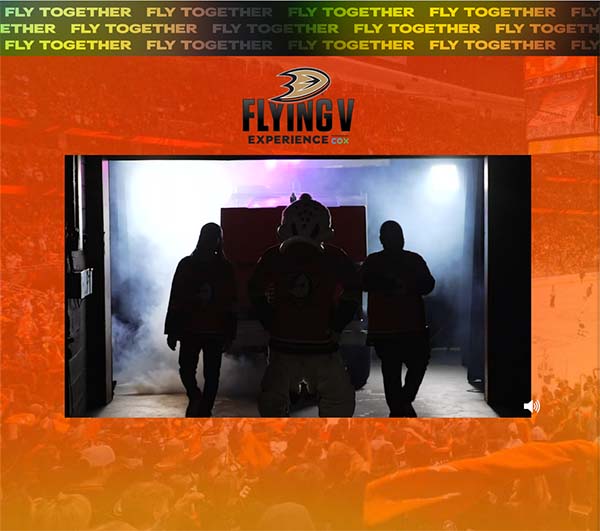
“We got to get over to the Zamboni tunnel right now. Let’s get over there,” Jojo said.
To the accompaniment of uptempo music, off went the intrepid trio.
Upon their on-video arrival, they met–ice engineer Kevin Diamond. Reports of his injury, Kevin said, were greatly exaggerated.
“My leg? I just broke my shoe! Got some new ones, see?”
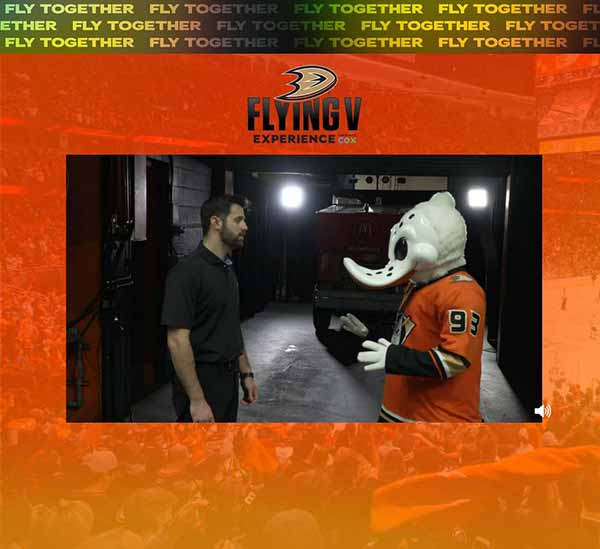
Kevin told Wild Wing he’d received good reports of his activities at the practice rink.
“Look–I know you worked hard. And I do need another crew member. Would you be willing to join our team?”
The duck nodded eagerly. But, apparently, he and Kevin had two different roles in mind.
“Not so fast. Only I drive the Zamboni,” Kevin admonished. He handed Wild Wing a shovel.
“This is for you.”
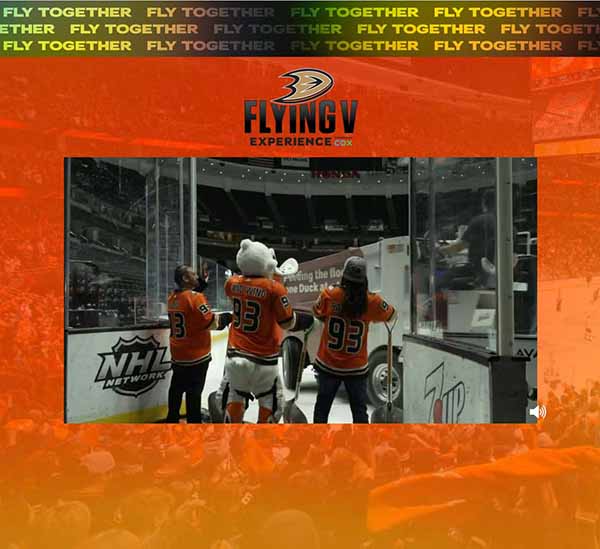
And Kevin drove off, in the Zamboni, on his mission to prepare the ice for the upcoming game.
The one predictable element
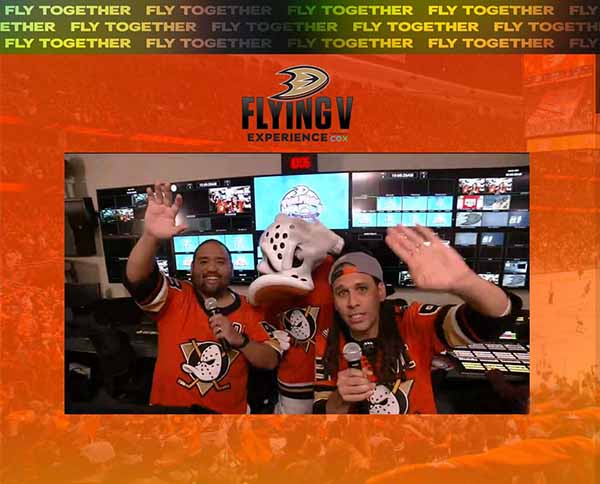
Now, anyone who’s ever produced a live event–broadcast, presentation or otherwise–knows there’s always one predictable factor.
That would be…unpredictability. Generally, technology is responsible.
With a broadcast background, we’ve seen computers update at the worst possible moment. Or cameras that worked perfectly, the previous day, “choke”, an hour prior to air. Not to mention recorders that balk, satellite feeds that just don’t “feed” properly. and mysterious noises and squeaks that weren’t present during tech rehearsal.
Something of that nature appeared to happen, just after Kevin drove off. We didn’t hear a concluding statement, and had the impression that the crew was dealing with an unexpected technical issue.
However, we were glad we stayed on the live-broadcast link.
Eventually, the entire “First Flight Field Trip” was rebroadcast, with an outro screen that asked, “Does Wild Wing keep his job? (Join us for our next game to see!)”
And the final frame invited guests to be on hand for the 2023 “First Flight Field Trip”. As listed on the S.C.O.R.E. website, the Ducks are hoping–and planning–that circumstances will allow them to host it live at Honda Center next spring.
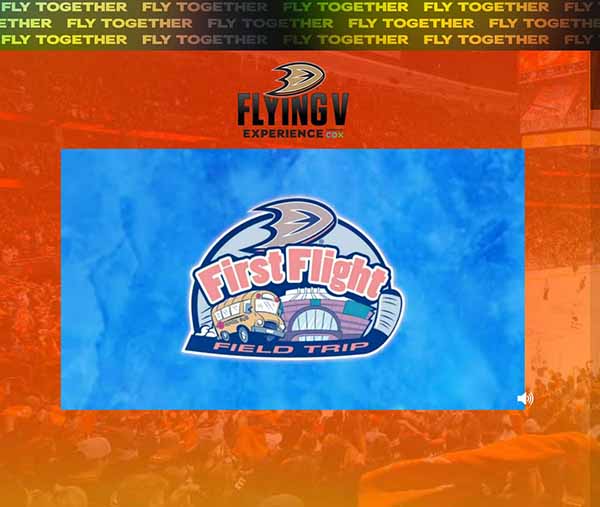
We couldn’t help but think of that slogan we saw in the backstage area of the practice rink: “Champions Do More”.
Great job, First Flight! We hope circumstances allow us to join you live in spring, 2023.
This is Part Two of a two-part series. Here’s our link to Part One.
(Warning: if you have a third- to sixth-grade classroom and would like to have them attend the 2023 “First Flight Field Trip”, contact S.C.O.R.E. early! Understandably, this unique free event “sells out” every year. According to this link, registration opens in October, 2022.)
